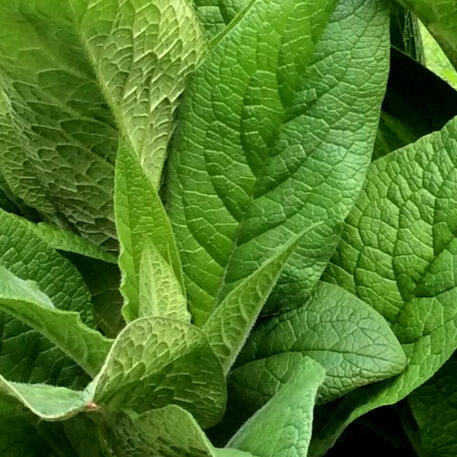-
Filter By Stock
- In Stock (0)
COMFREY
BOTANICAL NAME: Symphytum officinale
COMMON NAMES: Comfrey, Knitbone, Boneset
FAMILY: Boraginaceae
ORIGIN: Europe
PLANT DESCRIPTION
Comfrey is a herbaceous perennial herb. It has large, hairy leaves and grows in a rosette to 1 m in height given correct conditions. Plants have mauve flowers which are bell-like and borne in clusters. Comfrey rarely flowers in subtropical and tropical areas ascool conditions are required to induce flowering. In cooler areas the plant is dormant in winter and dies back only to reshoot in spring. The plant is quite hardy and will tolerate a range of conditions. It provides high yields on fertile, well-watered soil.
USES
The leaves are a useful addition to compost or used as mulch, as they contain silica, nitrogen, magnesium, calcium, potassium and iron. Comfrey is lush and fast-growing in the right conditions and can provide abundant supplies of mulch. When planted in the orchard, it can be slashed to provide mulch under fruit trees. Comfrey leaves, measured as dry matter, are about 15 to 30% protein which is as high as most legumes. The leaves readily decompose when soaked in water to make a liquid manure.
The whole plant is an excellent soil conditioner, the roots penetrate deep into the subsoil and are able to access nutrients beyond the reach of more shallow-rooted plants. This allows the gardener to cycle nutrients leached from the topsoil back to the surface by cutting comfrey leaves and using them as mulch. This deep nutrient mining is particularly useful for the health of soils in heavy rainfall areas. The large, deep roots of comfrey act to break up compacted soils. Plant comfrey downhill from poultry runs or animal pens to trap the nutrients that would otherwise be washed away in heavy rain.
Plants may also be used as a weed barrier which is effectively used to stop running grasses invading gardens. When planted for this purpose it should be in a strip several plants wide.
Comfrey leave may also be used as animal fodder and when left to flower make an excellent bee forage. The leaves are nutritious and readily eaten by poultry but should only be given in small quantities. Comfrey has been used as an animal forage for centuries but modern research suggests that in large quantities it can cause toxicity problems for grazing animals. Comfrey contains pyrrolizidine alkaloids (PA). The amount of PAs is highest in the roots. While the level of PAs in a green plant may not be very high, it can be a cumulative toxin. Pigs, horses, goats and cattle are most commonly poisoned by PAs, while sheep are much more resistant.
PLANTING GUIDE
In cool areas, roots should be planted in spring as plants die down over the winter. In warmer areas roots may be planted throughout the year. Comfrey may be propagated by root cuttings or crown division. Plant pieces of the root horizontally in the soil. The roots should be buried 3 cm deep and kept moist until the first leaves appear.
If a row of comfrey is required, or when planting around the base of a fruit tree, plants should be spaced at 50cm apart.
Comfrey should be planted in the final position the first time as any root disturbance will create new plants. If it has to be removed, simply cover the clump with several layers of wet newspaper and then top with mulch. The comfrey will rot out, leaving a rich, black compost.
COMPANION PLANTS
Establishing a weed free bed around your trees ensures that they can establish themselves without having to compete with grasses and weeds for nutrients. Comfrey outcompetes weeds and acts as a living ground cover at the same time. Plants can easily be slashed regularly with a whipper snipper to create an instant mulch. The plant has a deep tap root that can break through deep into the soil and uptake minerals that other plants cannot reach.
As a liquid fertiliser, comfrey 'tea' may be used as a high nutrient feed for tomatoes, capsicum, chilli and cucumbers. The comfrey leaves added to water and left over time will quickly break down. Resulting liquid should then be strained and The liquid should be applied as soon as the flowers have set fruit.

COMFREY (3 Root Cuttings)
(Symphytum officinale) European heirloom. Large, hairy, flattened leaves with mauve, bell-shaped flowers. Plant to 1m high. Dies back during winte
$10.95
